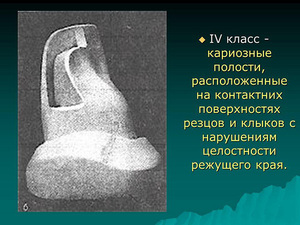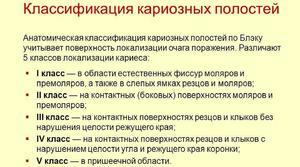Separation of carious lesions in dentistry: classification by Black, characteristics of classes
 The greatest distribution among all types of oral lesions was caries.The development of this disease is described in dentistry as intensive destruction of enamel and dentin crown.In the process of development, caries passes through two stages: the first is a carious stain, the second is the thinning and erasing of the hard tissues of the tooth.Abundant human consumption of carbohydrates contained in thermal food, and intense formation of soft plaque lead to the rapid multiplication of harmful bacteria that damage the integrity of the dental crown.
The greatest distribution among all types of oral lesions was caries.The development of this disease is described in dentistry as intensive destruction of enamel and dentin crown.In the process of development, caries passes through two stages: the first is a carious stain, the second is the thinning and erasing of the hard tissues of the tooth.Abundant human consumption of carbohydrates contained in thermal food, and intense formation of soft plaque lead to the rapid multiplication of harmful bacteria that damage the integrity of the dental crown.
In dentistry there are a number of factors that enhance the destructive effect of carious formations: oral hygiene, the consequences of the transfer of certain diseases, the lack of vitamins and minerals in the body, a stable state of stress.
 The risk of caries is in its ubiquitous manifestation of - from the fissures to the prigodnevyh areas of the teeth.Depending on the location of the carious cavity, the process of this disease differs.For the standardization of treatment methods for every practical case in dentistry, a classification of carious formations is carried out.
The risk of caries is in its ubiquitous manifestation of - from the fissures to the prigodnevyh areas of the teeth.Depending on the location of the carious cavity, the process of this disease differs.For the standardization of treatment methods for every practical case in dentistry, a classification of carious formations is carried out.
One of the most successful classifications to date, was offered by the dentist J. Blek .It allows you to distinguish the features of the process for each class, choose the appropriate method for sealing the carious tooth, most accurately describe the position of the painful area on the tooth surface.
Classification of carious formations, proposed by J. Blek
In total, five classes were allocated by Blake.The main condition for their separation is the localization of the carious area on the tooth surface. The lesion can be fixed in one area - in premolars, fissures, fossae of molars, canines and incisors;On two or more sites - occlusal, medial or distal surface of molars, premolars, canines and incisors.
First class
According to Black, in this case the formation of carious cavities occurs in fissures - in the chewing, buccal and palatine depressions. When dental treatment of , it is necessary to take into account the risk of breaking the seal as a result of high pressure on it.In this case, dentists apply the application of an additional layer of filling material.
 There is a different way to lay the composite for different curing materials: for light curing, the material is laid with oblique lines relative to the bottom of the affected area, for the chemical - the composite is applied parallel to the bottom.The superposed layers correspond to the direction from the middle of the carious cavity to its edge, and the reflection is realized along the lateral walls and perpendicular to the masticatory surface.Thanks to such operations, the seal fits tightly.
There is a different way to lay the composite for different curing materials: for light curing, the material is laid with oblique lines relative to the bottom of the affected area, for the chemical - the composite is applied parallel to the bottom.The superposed layers correspond to the direction from the middle of the carious cavity to its edge, and the reflection is realized along the lateral walls and perpendicular to the masticatory surface.Thanks to such operations, the seal fits tightly.
Stages of filling - I class.
- anesthetization of carious cavity
- drilling of the sealed area until reaching a hard tissue
- isolating the pulp from the composite if necessary
- exclusion from the prepared acid and saliva section
- primer application if necessary
- adhesive application
- Procedures: layering of curing material
- curing of composite
- treatment and polishing of seal
- final curing
Second class
By Black, in this case the formation of carious cavities occurs in molars and premolars on their contact surface. There are certain difficulties with in the treatment of second-class disease associated with the application of a filling material.Due to the overhang of the filling, the gingiva can undergo inflammation.In this case, Black uses the use of dental instruments - the matrix and wedges - to prevent painful contact.The matrix is placed between the teeth adjacent to the affected area.The wedges fixing the matrix are moistened with water to dislodge the tooth.
 Another difficulty is that the strength of the composite is determined by the position of caries in the cavity, and when the site with dentin is damaged, the composite loses adhesive properties.Then the use of an adhesive is highly recommended.
Another difficulty is that the strength of the composite is determined by the position of caries in the cavity, and when the site with dentin is damaged, the composite loses adhesive properties.Then the use of an adhesive is highly recommended.
Sealing stages - II class:
- cariesis anesthetics
- initial preparation,
- gum correction if necessary
- matrix and retaining wedge mounting,
- teeth spreading if necessary
- isolating the pulp from the composite if necessary
- exclusion from the prepared siteAcids and saliva
- primer application
- adhesive application
- restoration of the enamel when removed, if necessary
- holding mainCuring: layering of curing material
- matrix and wedge removal,
- composite curing
- sealing treatment and polishing
- final curing
Third and fourth grades
 According to Black, in this case the formation of carious cavities occurs on the surface of incisorsAnd canines, as well as their cutting edges. The main difficulty is that is the choice of color for the composite, because it is about the preparation of the front teeth, and therefore, about the area most noteworthy for others.The dentist needs to have an idea of the degree of transparency of the enamel and dentin to give homogeneity to the natural tissue and the seal.
According to Black, in this case the formation of carious cavities occurs on the surface of incisorsAnd canines, as well as their cutting edges. The main difficulty is that is the choice of color for the composite, because it is about the preparation of the front teeth, and therefore, about the area most noteworthy for others.The dentist needs to have an idea of the degree of transparency of the enamel and dentin to give homogeneity to the natural tissue and the seal.
Sealing steps - III and IV classes:
- Excision from the plaque
- Determination of the transparency of enamel and dentine,
- Caries cavity anesthesia
- Matrix installation if the gingival edge is affected
- Insulation of the pulp from the composite if necessary
- restoration of tooth contours if necessary
- exclusion from prepared acid and saliva
- primer application if necessary
-
 application of ASD6 ASD adhesive0ASD
application of ASD6 ASD adhesive0ASD - basic procedure: layering of curing material
- matrix extraction if used
- composite curing
- seal treatment and polishing
- final curing
Fifth class
According to Black, in this case the formation of carious cavities is localized inRegion located in the cervical( pridevnevoy) part of the tooth. The main problem for the dentist in treating the fifth grade disease will be the determination of the depth of the carious lesion with regard to the gums.Serious lesion complicates the treatment procedure by adjusting the gingival margin of the tooth.To the main process of setting the curing material, a pre-filling operation is added.According to the recommendations of Black, a composite is selected depending on the localization of the affected area.
Sealing steps - V class:
- exception from the prepared area of the plaque,
- definition of transparency of enamel and dentine,
- caries cavity anesthesia
- removal of softened tissue,
- correction of the tooth gingival margin if necessary
- matrix installation, If the gingival edge of the
- is affected, isolating the pulp from the composite if necessary
-
 exclusion from the prepared acid and saliva
exclusion from the prepared acid and saliva - primer overlap, ecwhether there is a need
- applying an adhesive
- conduct basic procedure: Overlay of cured material
- extraction matrix, if it was applied
- curing composite
- and polishing fillings
- final curing
Sixth grade
 StandardThe classification of Black on the initiative of WHO was introduced a new class of caries localization - the molars of molars, cutting edges of canines and incisors.The introduction of the sixth class was preceded by cases in dental practice, when the patient observed abnormal abrasion of tooth enamel on the protruding surfaces of the crown.
StandardThe classification of Black on the initiative of WHO was introduced a new class of caries localization - the molars of molars, cutting edges of canines and incisors.The introduction of the sixth class was preceded by cases in dental practice, when the patient observed abnormal abrasion of tooth enamel on the protruding surfaces of the crown.
Thus, to be limited to conventional sealing, applicable in cases described by Black, is not recommended. Treatment of pathology requires the intervention of a specialist , able to correct a defective bite of the patient and insert artificial crowns into the cavity.After such manipulations, the following problem may occur: a sealed molar loses contact with the antagonist tooth, which causes the natural occlusion of the jaws to be broken, so a composite veneer should be used for preparation, which will fill the gaps between the affected area and adjacent and opposite teeth.
The tasks assigned to the specialist in the treatment of caries
In practice, the dentist must adhere to a number of rules related to the treatment and prevention of caries.The following are the main tasks that the specialist aims to eliminate the negative consequences of the cure:
- The seal does not fit into the affected tooth without the preliminary cleaning of the carious cavity
- The damaged dentin is removed completely if it is not prevented by an exceptional practical case
- Damaged enamel is removed completely
- The affected tissue is removed due to the exclusion of infection of the oral cavity
- The cavity is exposed to boron to provide retentionLoss and Resistance of Tooth Teeth
- Prophylaxis of repeated manifestation of caries



